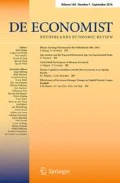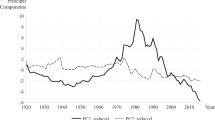Summary
The impact of domestic monetary policy in The Netherlands, Belgium and Austria on offsetting capital flows, interest rates and exchange rates is empirically investigated for the period 1973–1992. Offsetting capital flows are found to be incomplete for each country and lead to marginal interest and exchange rate effects only. A significant direct channel from excessive domestic creation to interest rises is present in Austria and to both interest and exchange rate rises in Belgium. No such effects are found for The Netherlands, possibly due to its adherence to targets for domestic money creation during the sample.
Similar content being viewed by others
References
De Nederlandsche Bank,Annual Report, various issues.
Dunnen, M. den (1992),Het monetaire beleid in België, Oostenrijk en Nederland, Studiedienstserie nr. 59, De Nederlandsche Bank, Amsterdam.
Fase, M.M.G., P. Kramer, and W.C. Boeschoten (1990),MORKMON II, het DNB kwartaalmodel voor Nederland, Monetaire Monografieën 11, De Nederlandsche Bank.
Fase, M.M.G., and C.C.A. Winder (1990), ‘The Demand for Money in The Netherlands Revisited,’De Economist, 138, pp. 276–301.
Fase, M.M.G., and C.C.A. Winder (1993), ‘The Demand for Money in The Netherlands and the Other EC Countries,’De Economist, 141, pp. 471–496.
Glück, H., D. Proske, and J.A. Tatom (1992), ‘Monetary and Exchange Rate Policy in Austria: An Early Example of Policy Coordination,’ in: H. Motamen-Scobie and C.C. Starck (eds.),Economic Policy Coordination in an Integrating Europe, Bank of Finland, Helsinki, pp. 163–202.
Haan, L. de, C.G. Koedijk, and J.E.J. de Vrijer (1992),De stijging van het liquiditeitsbezit in de jaren tachtig, Monetaire Monografieën 12, De Nederlandsche Bank.
Hochreiter, E. and B. Knöbl (1991), ‘Austria's and Finland's Exchange Rate Policy-Two Examples of a Peg,’De Pecunia, pp. 33–61.
Hochreiter, E. and G. Winckler (1992),Signaling a Hard Currency Strategy: The Case of Austria, Working paper 10, Oesterreichische National Bank.
Johnson, H.G. (1973), ‘The Monetary Approach to Balance of Payments Theory,’ in: M.B. Connolly and A. Swoboda (eds.),International Trade and Money, Allen and Unwin, London, pp. 206–224.
Kouri, P.J.K. (1975), ‘The Hypothesis of Offsetting Capital Flows-A Case Study of Germany,’Journal of Monetary Economics, 1, pp. 21–39.
Kouri, P.J.K., and M.G. Porter (1974), ‘International Capital Flows and Portfolio Equilibrium,’Journal of Political Economy, 82, pp. 443–467.
MacKinnon, J.G. (1990),Critical Values for Cointegration, Discussion paper 90-4, University of California, San Diego.
Mundell, R.A. (1963), ‘Capital Mobility and Stabilization Policy under Fixed and Flexible Exchange Rates,’Canadian Journal of Economics and Political Science, 29, pp. 475–584.
Nationale Bank van België,Annual Report, various issues.
Oesterreichische National Bank,Annual Report, various issues.
Roubini, N. (1988),Offset and Sterilization under Fixed Exchange Rates with an Optimizing Central Bank, NBER working paper no. 2777, Cambridge.
Author information
Authors and Affiliations
Additional information
This paper was written while the author was a visiting scholar at the Federal Reserve Bank of St. Louis. Manon den Dunnen provided excellent research assistance in collecting and summarizing available sources on actual monetary policy and instruments in Austria, Belgium, and The Netherlands. Useful comments on an earlier draft from Bill DeWald, Lex Hoogduin, Kees Koedijk, Ron van Rooden, Jack Tatom, Dan Thornton, Tom van Veen, and two anonymous referees are acknowledged. I am indebted to Paul Hilbers of the Dutch Central Bank for providing data on the exchange rate parities of the guilder and the Belgian franc during the 1970s. The usual disclaimer applies.
Rights and permissions
About this article
Cite this article
Kool, C.J.M. Monetary policy under fixed exchange rates: Lessons from the Netherlands, Belgium, and Austria, 1973–1992. De Economist 143, 329–351 (1995). https://doi.org/10.1007/BF01434012
Issue Date:
DOI: https://doi.org/10.1007/BF01434012




